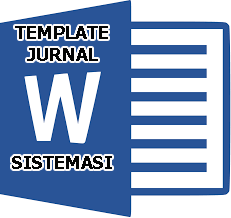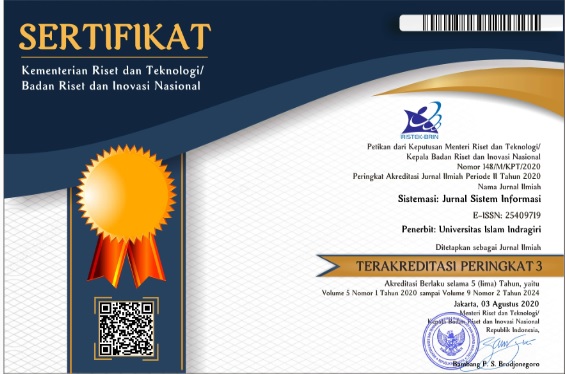Knowledge Acquisition for the Stunting Prevention Expert System (SIPENTING) using Decision Tree and Grid Search
Abstract
Keywords
Full Text:
PDFReferences
M. Tahangnacca, R. Amiruddin, Ansariadi, and A. Syam, “Model of Stunting Determinants: A Systematic Review,” Enfermeria Clinica, vol. 30, pp. 241–245, 2020, doi: 10.1016/j.enfcli.2019.10.076.
S. Supadmi et al., “Factor Related to Stunting of Children Under Two Years with Working Mothers in Indonesia,” Clinical Epidemiology and Global Health, vol. 26, no. May 2023, p. 101538, 2024, doi: 10.1016/j.cegh.2024.101538.
T. Huriah and N. Nurjannah, “Risk Factors of Stunting in Developing Countries: A Scoping Review,” Open Access Macedonian Journal of Medical Sciences, vol. 8, no. F, pp. 155–160, 2020, doi: 10.3889/oamjms.2020.4466.
T. Mulyaningsih, I. Mohanty, V. Widyaningsih, T. A. Gebremedhin, R. Miranti, and V. H. Wiyono, “Beyond Personal Factors: Multilevel Determinants of Childhood Stunting in Indonesia,” PLoS ONE, vol. 16, no. 11 November, pp. 1–19, 2021, doi: 10.1371/journal.pone.0260265.
M. Rosyidah, Y. L. R. Dewi, and I. Qadrijati, “Effects of Stunting on Child Development: A Meta-Analysis,” Journal of Maternal and Child Health, vol. 6, no. 1, pp. 25–34, 2021, doi: 10.26911/thejmch.2021.06.01.03.
W. R. W. Taib and I. Ismail, “Evidence of Stunting Genes in Asian Countries: A review,” Meta Gene, vol. 30, no. June, p. 100970, 2021, doi: 10.1016/j.mgene.2021.100970.
D. Hermawan, D. Kurniasari, V. Sandayanti, N. Sari, and E. Listyaningsih, “Relationships of Deworming Drug Consumption and Animal Protein Intake with Stunting,” Parasite Epidemiology and Control, vol. 23, no. October, p. e00326, 2023, doi: 10.1016/j.parepi.2023.e00326.
D. Arini, I. Fatmawati, D. Ernawati, and A. Berlian, “Hubungan Status Gizi Ibu Selama Hamil dengan Kejadian Stunting pada Bayi Usia 0-12 Bulan di Wilayah Kerja Puskesmas Kenjeran Surabaya,” EDUNursing, vol. 4, no. 1, Jul. 2020.
I. N. Ramadhani, Masni, A. Syam, A. Seweng, Stang, and R. Nur, “The Relationship Between Socioeconomic Status and Nutritional Status of Pregnant Women in Temporary Shelter, Talise, Palu,” Gaceta Sanitaria, vol. 35, pp. S171–S175, 2021, doi: 10.1016/j.gaceta.2021.10.018.
A. Basir et al., “Application Rule Base on Facial Skin Type Identification Expert System using Forward Chaining.” SISTEMASI: Jurnal Sistem Informasi, Vol 13, no 4,pp. 1427-1437, 2024.
D. Janjanam, B. Ganesh, and L. Manjunatha, “Design of an Expert System Architecture: An Overview,” Journal of Physics: Conference Series, vol. 1767, no. 1, 2021, doi: 10.1088/1742-6596/1767/1/012036.
F. A. Tyas, U. Ghoni, and S. Ismaya, “Penentuan Rule Base pada Sistem Pakar Identifikasi Jenis Kulit Wajah menggunakan Algoritma c4.5,” in Conference on Electrical Engineering, Informatics, Industrial Technology, and Creative Media 2023, Lembaga Penelitian dan Pengabdian Masyarakat (LPPM) Institut Teknologi Telkom Purwokerto, 2023, pp. 653–662.
C. J. Mantas and J. Abellán, “Credal-C4.5: Decision Tree based on Imprecise Probabilities to Classify Noisy Data,” Expert Systems with Applications, vol. 41, no. 10, pp. 4625–4637, 2014, doi: 10.1016/j.eswa.2014.01.017.
W. Nugraha and A. Sasongko, “Hyperparameter Tuning pada Algoritma Klasifikasi dengan Grid Search Hyperparameter Tuning on Classification Algorithm with Grid Search,” SISTEMASI: Jurnal Sistem Informasi, vol. 11, no. 2, pp. 391–401, 2022.
Y. Zhao, W. Zhang, and X. Liu, “Grid Search with a Weighted Error Function: Hyper-Parameter Optimization for Financial Time Series Forecasting,” Applied Soft Computing, vol. 154, no. February, 2024, doi: 10.1016/j.asoc.2024.111362.
M. Hussain et al., “A Security Framework for mHealth Apps on Android Platform,” Computers and Security, vol. 75, pp. 191–217, 2018, doi: 10.1016/j.cose.2018.02.003.
A. Saibene, M. Assale, and M. Giltri, “Expert Systems: Definitions, Advantages and Issues in Medical Field Applications,” Expert Systems with Applications, vol. 177, no. March, p. 114900, 2021, doi: 10.1016/j.eswa.2021.114900.
S. Shishehchi and S. Y. Banihashem, “A Rule based Expert System based on Ontology for Diagnosis of ITP Disease,” Smart Health, vol. 21, no. March, p. 100192, 2021, doi: 10.1016/j.smhl.2021.100192.
H. Rahman, M. Nulanda, N. Nurmadilla, A. S. Dewi, and S. Darma, “Analisis Status Gizi Ibu Sebelum Hamil terhadap Pemeriksaan Antropometri Luaran Bayi Baru Lahir di Rumah Sakit Nenemallomo Kabupaten Sidenreng Rappang Sulawesi Selatan,” vol. 4, pp. 5492–5508, 2024.
J. Abellán, C. J. Mantas, and J. G. Castellano, “AdaptativeCC4.5: Credal C4.5 with a Rough Class Noise Estimator,” Expert Systems with Applications, vol. 92, pp. 363–379, 2018, doi: 10.1016/j.eswa.2017.09.057.
S. Tangirala, “Evaluating the Impact of GINI Index and Information Gain on Classification using Decision Tree Classifier Algorithm,” International Journal of Advanced Computer Science and Applications, vol. 11, no. 2, pp. 612–619, 2020, doi: 10.14569/ijacsa.2020.0110277.
J. J. Purnama, Nina Kurnia Hikmawati, and Sri Rahayu, “Analisis Algoritma Klasifikasi untuk mengidentifikasi Potensi Risiko Kesehatan Ibu Hamil,” Journal of Applied Computer Science and Technology, vol. 5, no. 1, pp. 120–127, Jun. 2024, doi: 10.52158/jacost.v5i1.809.
M. Ogunsanya, J. Isichei, and S. Desai, “Grid Search Hyperparameter Tuning in Additive Manufacturing Processes,” Manufacturing Letters, vol. 35, pp. 1031–1042, 2023, doi: 10.1016/j.mfglet.2023.08.056.
F. A. Tyas, U. Ghoni, and S. Ismaya, “Penentuan Rule Base pada Sistem Pakar Identifikasi Jenis Kulit Wajah menggunakan Algoritma c4.5,” in Conference on Electrical Engineering, Informatics, Industrial Technology, and Creative Media 2023, 2023, pp. 653–662.
C. Zhang and J. Han, Data Mining and Knowledge Discovery Handbook. Boston, MA: Springer US, 2010. doi: 10.1007/978-0-387-09823-4.
C. Hasanudin, A. Fitrianingsih, D. Nuri, P. Utomo, M. Abu, and R. Baihaqi, “Strategies to Create Digital Learning Materials of Early Reading for Elementary School Students using Kodular,” International Conference on Education Innovation and Social Science, pp. 34–47, 2022.
DOI: https://doi.org/10.32520/stmsi.v14i3.5004
Article Metrics
Abstract view : 479 timesPDF - 71 times
Refbacks
- There are currently no refbacks.

This work is licensed under a Creative Commons Attribution-ShareAlike 4.0 International License.









